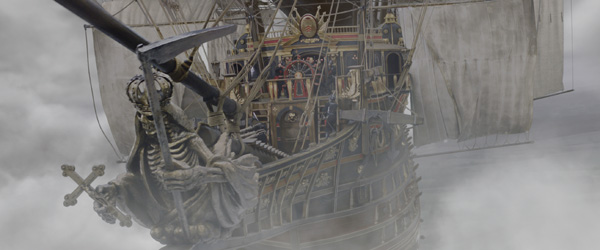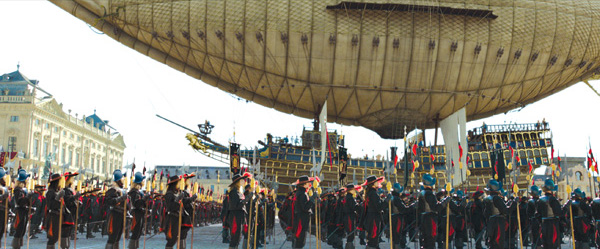New Direction
“D’Artagnan’s triumph at dawn over Paris involved the entire city, two destroyed airships and Notre Dame - all resident in the scene at once. We also had the performances of our digital doubles on the roof to highlight, and make sure that they weren't overshadowed by the environment.
Aside from the heaviness of the shot, the lighting was actually fairly straightforward. We used soft boxes, or area lights, and spots for key and rim lighting, and a sunset HDRI map for fill light. Each light source was separated out and given to our compositors as diffuse and specular contribution, so we were able to adjust the light additively and subtractively after the render. The backlit sails also required separate rendering from the rest of the ships.
The god rays and flares were achieved in comp. Flares in particular are very tricky to pull off well in stereo, when they are not equally visible in both eyes. It’s preferable to achieve these types of looks in comp where they're much quicker to dial in.
The wide shots, among the most distinctive and memorable in this film, were a new direction for Mr X due to their complexity. “The airships with their millions of polygons plus multiple CG characters on board represented huge amounts of data to push through the pipeline. Wide shots of Paris actually required writing propriety tools to handle so much data at one time. At times, rendering in stages is preferable for the compositors because it give them more flexibility, But in most cases when we needed to we managed to optimize the data enough to render entire scenes at once.”
Parting Shot
The final shot is a view from over the open sea, populated with a fleet of graceful sailing ships was very complex to put together, starting with a matte painted environment so that the water would reflect and refract it correctly. The cameras were positioned to show a bright area of the sun creating a strong highlight on the water that shows off its movement, achieved through several layers of animation. Large breakers 10m long were combined with secondary and tertiary ripples travelling with the wind with enough detail to indicate the camera was about 100m high at the end of the shot.
Meanwhile a dynamic simulation of the ships’ hulls moving through the water was required. This level of extra detail was needed to fix the relationship between the plate element – onboard the hero ship where Buckingham stands – and the team’s virtual camera as it pulls up and back. Instead of moving the ships through the water, establishing this allowed them to simply move the water past the ships. They also had to be careful about adding motion to the ocean, as distorting the plate would affect the photo element of one of the film’s stars.
The fleet of ships was laid out in a carefully distributed wedge pattern, balancing out a fleet of airships overhead in the sky. The final composition of 46 airships and 54 sea ships had to look impressively full and pleasing as the camera pulls away. The ranks of ships also needed enough variation in sail animation. Generic cloth simulations or caches could be baked into the rigging. The duration of these were prolonged to allow the offset to be changed between the various sails and avoid repetitive motion.
Lighting Supervisor Trey Harrell and the lighting team had a special involvement on this shot. “This was a huge collaboration across teams for us,” said Trey. “The water was rendered by Jeremy Dineen in the effects department, comprising hundreds of 4K water tiles fully simulated inside Mr X’s proprietary water system inside Houdini. The sky was based on a matte painted sky dome to create a very stylized sunrise scene, including the composition and colour palette the compositing department added sun and sun flares. The sun’s reflection was rendered in both the effects and lighting departments.
“All air and sea ships balloons, sails and flags were sent through the cloth department and then back to lighting. All of Buckingham’s airships – with 48 million polygons in each - were rendered simultaneously, taking about 12 minutes per pass. Careful planning kept this sequence from becoming a problem, as everyone almost expected.” Lighting of the water was in the end relatively straightforward. A proprietary crowd system was used for the ships, rendering several hundred hold out mattes for the compositing team to affect each ship individually down to the colour of the metal on them, and give different dirt maps to each ship, to balloons to weathering maps and to sails.
“Knowing in advance how challenging the water would be and showing this shot’s epic nature without revealing repetition, we decided to push the revision into the compositors’ arena. It was a 700 to 800 frame shot and this much control was very useful because to have to re-render would have been too expensive,” said Trey. Following such a huge planning effort, they succeeded on just version three.
Words: Adriene Hurst
Images: Courtesy of Constantin Film




















